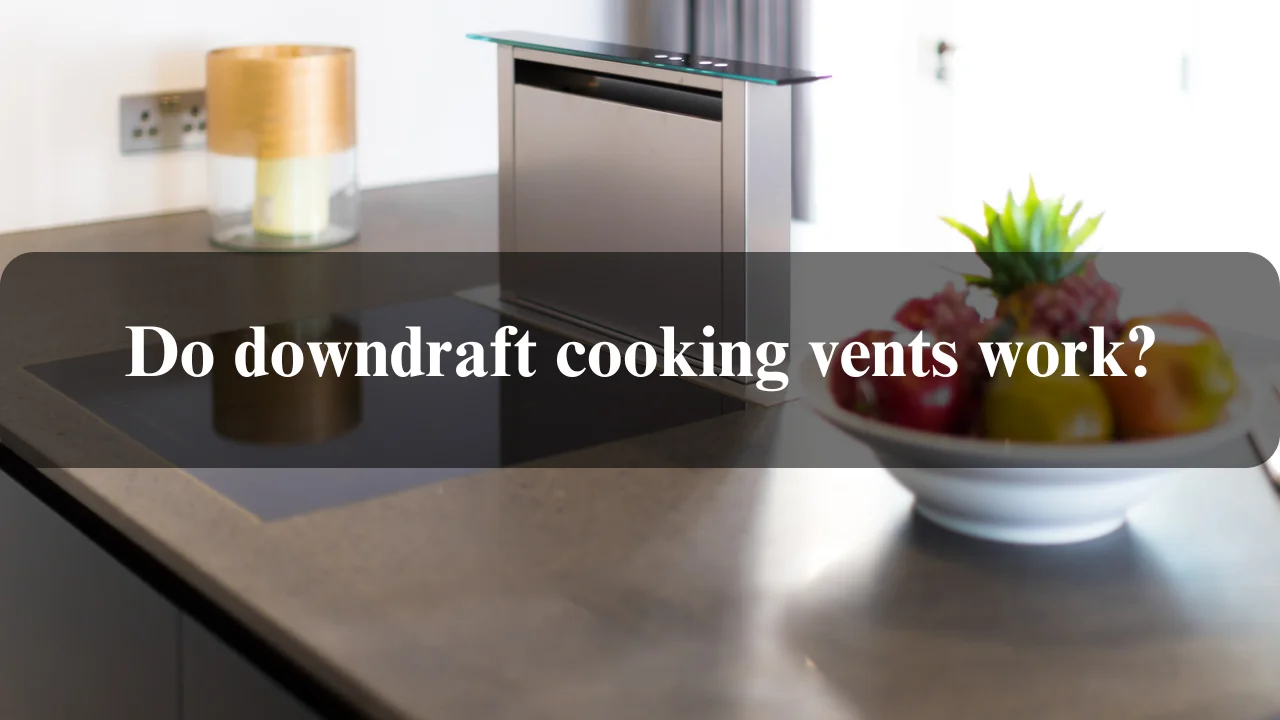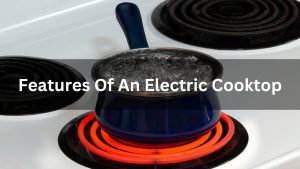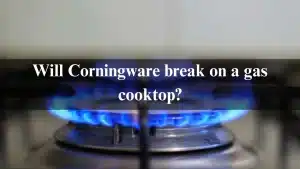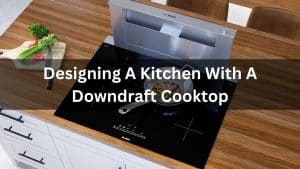When it comes to cooking, the right ventilation can make all the difference. Whether you’re sautéing vegetables or searing a steak, managing smoke and odors is essential for a pleasant kitchen experience. Enter downdraft cooking vents—a stylish and innovative solution gaining popularity among home chefs. But do they live up to the hype?
In this blog post, we’ll explore what downdraft cooking vents are, how they stack up against traditional range hoods, and how they work their magic in your kitchen. Get ready to discover if this sleek option is the right fit for your culinary adventures!
Table of Contents
What Are Downdraft Cooking Vents?
Downdraft cooking vents are a modern kitchen feature designed to improve air quality while cooking. Unlike traditional range hoods that hang overhead, these systems are built into the cooktop or countertop.
When you turn on a downdraft vent, it rises from behind your stove. This innovative design allows seamless integration into your kitchen layout, maintaining an open feel without bulky equipment taking center stage.
These vents capture smoke, steam, and odors right at the source. They draw air downwards and out of the home through ductwork installed beneath the floor or cabinetry.
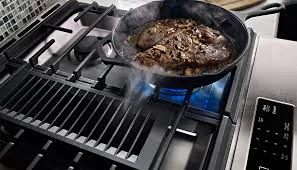
This functionality can be particularly appealing in kitchens with limited space or those aiming for a sleek aesthetic. Downdraft cooking vents offer both style and practicality in one convenient package.
How Do Downdraft Vents Differ From Traditional Range Hoods?
Downdraft vents and traditional range hoods serve the same essential purpose: to remove smoke, steam, and odors from your kitchen. However, their design and functionality set them apart.
Traditional range hoods are typically mounted above the cooking surface. Due to their height, they effectively capture rising heat and fumes. This design works well in most kitchens but can dominate space with bulkiness.
In contrast, downdraft vents are integrated into the cooktop or installed behind it. When activated, they rise from their hidden position to efficiently pull air downwards. This sleek approach allows for a more open kitchen layout while maintaining aesthetic appeal.
Another key difference is installation flexibility. Downdrafts can fit seamlessly into island setups where overhead ventilation isn’t feasible, offering versatility that traditional hoods may lack. Each option has its merits; understanding these distinctions helps you make an informed choice for your culinary environment.
How Does a Downdraft Vent Work?
Downdraft cooking vents operate differently than traditional range hoods. Instead of pulling smoke and odors upwards, they draw them down through strategically placed ducts. When you turn on the downdraft vent, it activates a fan that pulls air downward.
Typically installed in cooktops or slide-in ranges, these vents can extract steam and smell at the source. This function is particularly beneficial for open-concept kitchens where aesthetics are important. A downdraft vent sits discreetly behind the cooking surface until needed; with a button push, it rises to do its job.
These systems usually include filters that help capture grease particles from the air. The collected particles are directed away through ductwork to an exhaust point outside your home or recirculated after filtration.
While downdraft cooking vents may not be as powerful as some traditional hoods, they provide effective ventilation without compromising style. They are ideal for those who want to maintain clean lines in their kitchen design while still enjoying functional performance during meal preparation.
They understand how downdraft cooking vents work and will help you decide if they suit your culinary needs and kitchen setup. With their sleek design and practical functionality, they might be what you’re looking for in modern kitchen ventilation solutions.
Do Downdraft Cooking Vents Work as Effectively as Range Hoods?
Downdraft cooking vents offer a sleek solution for modern kitchens, but their effectiveness is often debated compared to traditional range hoods.
Range hoods are designed with powerful suction that captures smoke and steam rising directly from the cooking surface. They create a direct airflow path that efficiently removes contaminants.
On the other hand, downdraft vents pull air downward rather than upward. This can be less efficient at capturing the smoky particles immediately rising from pots and pans.

While downdrafts work well for lighter tasks like simmering or sautéing, heavier frying might produce more emissions than they can handle. The design also limits their reach compared to standard overhead options.
If aesthetics matter as much as performance in your kitchen space, you may need to weigh your priorities carefully before choosing between these two ventilation styles.
Airflow and Smoke Capture
Downdraft cooking vents are designed to pull air downward, which can be effective in certain kitchen layouts. They work by drawing smoke and odors away from the cooking surface.
However, their performance is closely tied to airflow dynamics. When a pot bubbles over or sears meat, lifting heat and steam into the air, downdrafts may struggle to immediately capture all that rising smoke.
Unlike traditional range hoods that hover above the cooktop, these vents rely on vertical suction. This means they might not catch every whiff of odor or plume of grease quickly enough.
The effectiveness often depends on the design of your kitchen as well. Open spaces with high ceilings can diminish their efficiency because smoke has more room to disperse before it reaches the vent’s reach.
Ventilation Power and Efficiency
Ventilation power is crucial when considering downdraft cooking vents. These systems are designed to pull air down and away from the cooking surface. However, their efficiency can vary significantly.
Many models may not match the robust airflow of a traditional range hood. Range hoods typically offer higher CFM (cubic feet per minute) ratings, which translates to greater smoke and odor removal capabilities.
Additionally, downdraft vents often struggle with larger appliances or multiple burners. Their effectiveness diminishes when faced with intense heat or volatile cooking methods like frying.
Efficiency also hinges on ducting design. A straight path enhances performance, while bends and turns can considerably hinder airflow. If you’re seeking effective ventilation for heavy-duty cooking, consider how these factors influence your choices in kitchen design.
Noise Levels and Fan Speed
Noise levels can be a significant factor when choosing kitchen appliances. Downdraft cooking vents produce varying sounds based on design and fan speed settings.
Many models come with multiple speed options. This versatility allows users to select the appropriate setting for different cooking tasks. A higher speed may effectively capture smoke and odors but often increases noise levels.
Conversely, lower speeds are quieter but might not provide optimal airflow during heavy cooking sessions. It’s essential to balance performance and comfort in your kitchen environment.
Some advanced downdraft systems incorporate sound-dampening technology, reducing operational noise without sacrificing efficiency. For those who value peace while they cook, these options could be worth considering.
Understanding how fan speed impacts noise can help you decide which downdraft vent best suits your culinary lifestyle.
What Are the Advantages of Downdraft Cooking Vents?
When designing a modern kitchen, functionality, and style are key considerations. One innovative solution that combines both is the downdraft cooking vent. Unlike traditional overhead hoods, downdraft vents offer a more streamlined approach to kitchen ventilation, pulling smoke, steam, and odors downward and away from the cooking area. This design not only enhances the overall look of your kitchen but also provides practical benefits that can make a big difference in how you use your space. Let’s explore some key advantages of downdraft cooking vents.
- Space-Saving Design: Downdraft vents eliminate the need for bulky overhead range hoods, freeing up valuable kitchen space. This is especially beneficial in kitchens with limited room or island setups where overhead venting could be more practical.
- Improved Aesthetic Appeal: Without the visual clutter of an overhead hood, downdraft vents create a sleek, modern look. They allow for open sightlines, making the kitchen more spacious and polished.
- Flexibility in Kitchen Layout: Since downdraft vents are built into the cooktop, they offer more flexibility in kitchen design. You can place the cooktop on an island, against a wall, or even near a window without worrying about where to install a traditional hood vent.

These features make downdraft vents popular for those looking to balance style, space, and kitchen functionality.
Are There Any Disadvantages to Downdraft Cooking Vents?
While downdraft cooking vents offer a modern solution for kitchen ventilation, they have drawbacks. One major issue is their limited performance, especially when handling large pots and pans. The downward airflow can struggle to capture smoke and steam effectively, leaving lingering odors behind effectively.
Installation challenges can also arise. Downdraft systems often require precise placement within your cabinetry or cooktop design. This may limit your options during renovations or new builds.
Additionally, some users notice reduced cooking power compared to traditional range hoods. They might not be as effective in removing heat and moisture from the air, affecting overall cooking efficiency.
Cleaning these systems can be more cumbersome than expected in terms of maintenance due to their location and potential grease buildup over time.
- Limited Performance with Large Pots and Pans
Downdraft cooking vents can need help to handle large pots and pans. Their design draws air downwards, which may need to capture smoke or steam from bigger cookware more effectively.
Heat rises rapidly when sautéing vegetables in a wide skillet or boiling pasta in a hefty pot. This natural phenomenon often leads to an escape of odors and grease that downdraft systems might miss.
Another factor is the positioning of these vents. They are usually located at the back of the cooktop, making it difficult for them to catch emissions from larger items placed farther away.
This limitation could affect your cooking experience if you frequently use sizable cookware. If most of your meals involve big batches or elaborate dishes, consider how well these vents will serve you in practice.
- Installation Challenges
Installing downdraft cooking vents can pose some unique challenges. Unlike traditional overhead hoods, these systems require more careful planning and precise measurements.
One major concern is the need for adequate ductwork. If your kitchen layout doesn’t already accommodate this, you may face significant renovations, which can add time and expense to your project.
Another point to consider is height clearance. Downdraft vents are typically integrated into cooktops or countertops, so it can be tricky to ensure they fit seamlessly with existing cabinetry.
Additionally, positioning is crucial. The vent must align well with your cooking surface to remove smoke and odors. Misalignment could lead to better performance and satisfaction over time.
You’ll also want to consider power sources for models equipped with electric fans. Ensuring access to electricity during installation might complicate matters further if it wasn’t previously planned for in your kitchen design.
- Reduced Cooking Power
Reduced cooking power can be an overlooked drawback of downdraft cooking vents. Unlike traditional overhead hoods, these systems often struggle to keep up with high heat and steam from intense cooking.
The vent may not provide sufficient suction when using large pots or during multi-pan meals, leading to lingering odors and smoke in the kitchen. The design is meant for more casual cooking scenarios rather than heavy-duty culinary tasks.
Moreover, some models require a higher fan speed to capture smoke and steam effectively, which could interfere with your cooking ability at optimal temperatures. This limitation might become frustrating over time if you enjoy sautéing or frying frequently.
Thus, assessing your cooking style is essential before committing to a downdraft system. Better options may be available for those who love experimenting with recipes that demand robust performance.
How Do Downdraft Vents Compare to Other Ventilation Options?
Downdraft vents offer a unique approach to kitchen ventilation, standing out from traditional options. Unlike overhead range hoods that hang above the cooking surface, downdraft systems pull smoke and odors downwards, making them ideal for open layouts.
One major difference between downdraft vents and overhead range hoods is aesthetics. Downdrafts are sleek and discreet, integrating seamlessly into countertops or cooktops. However, their suction power can be less effective with larger pots and pans.
Induction cooktops with integrated vents take this concept further by combining heating elements with built-in extraction systems. This design maximizes space while minimizing the appearance of separate appliances. Yet these setups require specific cookware to work efficiently.
While all ventilation options have pros and cons, your choice depends on kitchen layout, style preferences, and cooking habits. Each system has its place within modern kitchens, depending on individual needs.
Downdraft Vents vs. Overhead Range Hoods
Functionality is crucial when choosing between downdraft vents and overhead range hoods. Downdraft vents are sleek and often integrated into cooktops. They pull smoke and odors downwards, which is ideal for modern kitchens with open layouts.
Overhead range hoods, on the other hand, are powerful. Their ability to capture steam and grease is superior due to their positioning above the cooking surface. These units generally feature stronger motors that can handle heavy-duty cooking more effectively.
Another factor is aesthetic preference. Downdrafts offers a minimalist look while preserving sightlines in an open kitchen space. Range hoods come in various styles that can serve as statement pieces or complement your decor but may take up more visual space.
Consider your cooking habits when making this choice; frequent frying or grilling might benefit from the robust suction of a traditional hood over a downdraft system’s limited capacity.
Downdraft Vents vs. Induction Cooktops with Integrated Vents
Downdraft and induction cooktops with integrated vents offer distinct advantages in modern kitchens. Downdraft vents provide flexibility, fitting seamlessly into various kitchen layouts. They pull smoke and odors downwards, making them a practical choice for island installations.
On the other hand, induction cooktops with built-in ventilation systems are designed to maximize efficiency. The vent works directly above the cooking surface, capturing steam and smells right where they originate. This can create a cleaner cooking experience.
However, it’s essential to consider installation requirements for both options. Induction cooktops often require a more specialized setup compared to downdrafts. Depending on your kitchen design and personal preferences, one may suit you better.
Each option has a unique appeal based on aesthetics and functionality, allowing homeowners to tailor their ventilation solutions to specific needs.
Are Downdraft Vents a Good Fit for Your Kitchen?
Evaluating your kitchen’s layout and design is essential when considering downdraft cooking vents. Open kitchens often benefit from their discreet nature. With no overhead obstruction, they promote a sleek aesthetic.
If you have an island cooktop, downdraft vents can be particularly advantageous. They save space and maintain the clean lines that modern designs crave. However, you’ll want to ensure proper placement for maximum efficiency.
Remember that these vents may only suit some cooking styles or sizes of cookware. Performance might fall short if you’re a fan of large pots or heavy-duty equipment.
Before installing downdraft vents in your kitchen, assess how you cook daily and what features matter most to you.
Considerations for Open Kitchens
Open kitchens create a seamless flow between cooking and living spaces. However, this design can present unique challenges regarding ventilation.
Downdraft cooking vents might capture smoke and odors less effectively in an open setting. Without walls to contain the air, smells may linger longer than desired.
Think about your kitchen layout. If it’s connected directly to dining or entertainment areas, you want a solution that doesn’t disrupt the ambiance with lingering fumes.
Also, consider noise levels. Downdraft systems can be quieter than overhead hoods, which is beneficial during gatherings where conversation matters most.
Aesthetics play a role, too. A downdraft vent tucks away neatly when not in use, maintaining the clean lines of your open space while ensuring functional airflow during cooking sessions.
Island Cooktop Installation
Installing a downdraft vent with an island cooktop can be stylish and functional. It allows for an open kitchen design while quickly removing smoke and odors from the cooking area.
One key consideration is the placement of the downdraft unit. To maximize efficiency, it should align perfectly with your cooktop. This positioning effectively captures rising steam and grease.
Electrical and ductwork requirements also come into play during installation. Ensure you have access to power sources nearby and a way to vent air outside if needed. This could involve additional modifications to your space.
Think about aesthetic elements like cabinetry or decor around your island. A seamless integration will enhance functionality and visual appeal, making your kitchen practical and inviting for family gatherings or entertaining guests.
How to clean a downdraft vent?
Cleaning a downdraft vent is essential to maintain its efficiency. Start by unplugging the unit for safety.
Remove any accessible filters or panels. Most models have removable components that can be washed in warm, soapy water.
Use a soft brush or sponge with a non-abrasive cleaner for stubborn grime. Be careful not to scratch the surfaces.
Once clean, rinse thoroughly and let everything dry completely before reassembling.
Next, check the ducts to see if your downdraft vent connects to external ventilation. Dust and debris can accumulate over time, affecting performance. A vacuum attachment designed for this purpose will clear out any build-up.
Regular maintenance every few months will keep your downdraft cooking vents working efficiently and looking great.
Do downdraft vents need to be vented?
Depending on the model and kitchen setup, downdraft vents can operate with or without external venting. Many units are designed to recirculate air through a filter system, which works well for those who may not have access to ductwork.
However, connecting downdraft vents to an external ventilation system is often recommended for optimal performance. Venting outside more efficiently eliminates smoke, odors, and excess heat than recirculation alone.
Consider your cooking habits when deciding whether venting is necessary. If you frequently use high-heat methods like frying or searing, opting for a ventilated system will likely enhance your cooking experience.
Installing downdraft vents in kitchens without proper ventilation might limit their effectiveness. So, understanding your space and needs before deciding can save you from future frustrations.
Related Articles:
How Effective Are Downdraft Vents In The Kitchen? 2024
Are Downdraft Extractors More Effective In 2024?
Downdraft Cooktops Read All The Latest Pros And Cons 2024
Designing A Kitchen With A Downdraft Cooktop In 2024
Conclusion
In conclusion, downdraft cooking vents offer a sleek, space-saving alternative to traditional range hoods, perfect for modern kitchens aiming to balance style and functionality. While they may not be as powerful as overhead hoods for handling heavy-duty cooking, they work well for lighter tasks and kitchens with specific design needs. By understanding their pros and cons, you can decide if a downdraft vent is the right choice to enhance your cooking experience.
FAQs
Are downdraft cooking vents effective?
Yes, downdraft cooking vents can effectively capture smoke, steam, and odors while you cook. However, their performance may not match that of traditional overhead range hoods.
Can I use a downdraft vent with any type of cooktop?
Downdraft vents are typically designed to work best with certain cooktops, such as gas or electric ranges. It’s essential to check whether your specific model is compatible.
Do I need to vent my downdraft system outdoors?
While some models can recirculate air without external venting, it’s generally recommended to vent outside for better odor and smoke removal.
How do I clean my downdraft vent?
Cleaning a downdraft vent involves removing the filter and washing it according to the manufacturer’s instructions. Regular maintenance helps keep your system functioning efficiently.
What should I consider when installing a downdraft in an island kitchen?
For island installations, ensure enough space around the unit for optimal airflow. Additionally, plan for electrical and ventilation requirements during installation.
Are there noise concerns with downdraft vents?
Some users report that certain models are noisier than others. If noise is a concern for you, checking reviews before purchasing can help you find a quieter option.
Do downdraft cooking vents work?
Yes, downdraft vents can effectively remove steam, smoke, and odors, but their efficiency depends on your cooking type and the system’s power.
Can downdraft vents handle heavy cooking tasks like frying?
Downdraft vents may struggle with high-smoke cooking like frying or grilling, especially with larger pots or pans.
How do downdraft vents compare to range hoods?
Range hoods tend to be more powerful and efficient, but downdraft vents offer a more aesthetic and space-saving option.
Are downdraft vents more expensive to install?
Downdraft vents can be more complex and expensive to install due to the need for under-floor or wall ductwork.

